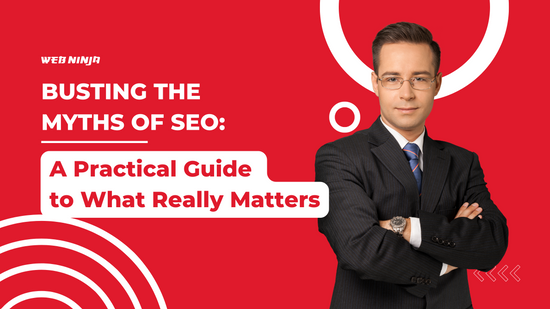Busting the Myths of SEO: A Practical Guide to What Really Matters
Updated on 26 May 2025 | By Jeffrey Almarez | 5-minute read
Search engine optimisation (SEO) gets talked about a lot—but not always accurately. Whether you're a business owner, marketer, or web developer, you’ve likely heard conflicting advice. One blog says keywords are king; another insists they're obsolete. Some promise overnight rankings with a few "hacks", while others make SEO sound like an impenetrable science.
No wonder it feels hard to keep up.
But here's the thing: SEO isn't magic. It's strategic, evidence-based, and built on a foundation of quality, consistency, and user value. In this guide, we’ll unpack common SEO myths with a practical lens—backed by industry expertise and real-world experience—to help you focus your efforts where they matter most.
Myth 1: SEO Is Just About Keywords
Reality: Keywords still play a role—but they're only part of the story.
Once upon a time, you could cram a page full of exact-match keywords and expect to rank. That era is long gone. Today’s search engines are much smarter, with Google’s natural language processing (like BERT and MUM) allowing it to understand context, intent, and topic relevance.
What to focus on instead:
- Use keywords naturally within meaningful content.
- Target broader themes or “topics” instead of isolated keywords.
- Write for your reader, not the algorithm.
Example: If you're running an online vet clinic software, don't just target “vet appointment system”—build informative content around “how to manage a veterinary practice efficiently” or “tools to improve pet owner communication”.
Myth 2: You Can Game the Algorithm for Quick Wins
Reality: Shortcuts backfire. Search engines are designed to reward long-term, user-first strategies.
Google's algorithm updates—from Panda and Penguin to the more recent Helpful Content Update—have consistently pushed websites toward better, more authentic experiences. Trying to "outsmart" Google with tricks like link schemes or content cloaking usually results in penalties.
The Harvard Business Review emphasises that ethical digital strategies build brand trust and credibility—both essential to SEO. And as Google increasingly ties rankings to trust and authority, those who play the long game will always outperform those chasing loopholes.
Myth 3: Meta Tags Are the Secret to High Rankings
Reality: They're helpful—but not nearly enough on their own.
Yes, title tags and meta descriptions help search engines understand your page. They also influence click-through rates from search results. But if the content behind them lacks depth, structure, or relevance, rankings will suffer.
Instead, ensure:
- Your title tags are concise, relevant, and match search intent.
- Meta descriptions summarise the page without sounding like spam.
- The content itself delivers on what’s promised in the meta.
Think of meta tags as your storefront signage—they get attention, but what’s inside keeps customers coming back.
Myth 4: More Backlinks = Better Rankings
Reality: Not all backlinks are equal.
Ten links from obscure directories won’t do as much as one quality link from an authoritative, relevant site. Google's focus is on link quality, not sheer volume.
What counts as a quality backlink?
- Comes from a reputable, relevant domain (e.g., a local industry association or niche blog).
- Contextually placed within useful content.
- Not part of a paid or link exchange scheme.
Moz and Ahrefs both stress the importance of earning links through value—think guest posts, case studies, original data, and digital PR strategies.
Myth 5: SEO Is a One-Time Task
Reality: SEO is ongoing—it’s never “done.”
This misconception often leads businesses to invest heavily in a website redesign or initial SEO setup, only to neglect the site for months or years. Meanwhile, search engines keep evolving, competitors keep optimising, and user behaviour keeps shifting.
What ongoing SEO looks like:
- Regular content updates and audits.
- Technical checks (site speed, indexing, mobile usability).
- Monitoring search performance and adjusting strategies.
- Keeping pace with algorithm updates.
A good analogy? SEO is like fitness—it’s not about one big workout but a consistent regimen.
Myth 6: Speed Scores Tell the Whole Story
Reality: Tools like PageSpeed Insights or GTmetrix offer great insights—but don’t obsess over scores alone.
These scores can sometimes be misleading, especially when they emphasise technical optimisations over real user experience. Google's Core Web Vitals, for instance, measure things like load time, interactivity, and layout stability—because these directly impact how users perceive your site.
Better performance goals:
- Fast load time (under 3 seconds is ideal).
- Smooth mobile usability.
- Limited third-party script impact.
- Efficient, clean code.
According to Think with Google, even a one-second delay in page load can reduce conversions by up to 20%.
Myth 7: CDNs and Caching Solve All Performance Problems
Reality: They help—but they’re not magic bullets.
Content Delivery Networks (CDNs) distribute your website content across global servers to speed up delivery. Caching stores website data to reduce load times. But if your site is bloated with unused CSS, broken JavaScript, or unoptimised images, these tools can only do so much.
Best practice:
- Minimise unused code.
- Use modern image formats (like WebP).
- Combine caching with lightweight design and efficient development.
This aligns with the Australian Government’s Digital Service Standard, which recommends that public websites prioritise performance and accessibility as core user needs.
Myth 8: Desktop Optimisation Is Enough
Reality: Mobile-first is now the default.
Google switched to mobile-first indexing in 2019, meaning it primarily looks at your mobile site to determine rankings. And with over half of global web traffic now on mobile, ignoring mobile optimisation means losing visibility, traffic, and conversions.
Ensure mobile readiness with:
- Responsive design across screen sizes.
- Touch-friendly navigation.
- Compressed media for fast loading.
- Accessible layouts and readable fonts.
Run your site through Google’s Mobile-Friendly Test to check how you’re doing.
Myth 9: IT Handles Web Performance Alone
Reality: SEO is a team sport.
While your dev team plays a crucial role in technical SEO, designers, writers, marketers, and even sales teams influence how your site performs and ranks.
For example:
- Designers shape usability and site structure.
- Content creators build relevance and authority.
- Marketers ensure content aligns with user intent.
- Developers handle speed, accessibility, and crawlability.
Encouraging collaboration across departments leads to better SEO outcomes—and a better experience for your users.
Myth 10: SEO Doesn’t Affect Conversions
Reality: It does—more than you think.
Slow websites, confusing layouts, or irrelevant content don’t just hurt rankings. They frustrate users, drive them away, and damage your reputation.
Good SEO enhances:
- Visibility (they find you)
- Credibility (they trust you)
- Usability (they stay)
- Relevance (they convert)
The Australian Competition and Consumer Commission (ACCC) has highlighted that user trust in digital experiences directly affects purchasing behaviour—further emphasising the value of well-optimised websites.
Moving Forward: What Really Works in SEO?
If you take one thing from this post, let it be this: SEO isn't about chasing algorithms. It's about consistently delivering real value to your audience—through relevant content, accessible design, fast performance, and trustworthy information.
Here’s a quick summary of where your focus should be:
- Content: Useful, original, well-structured, and aligned with user intent.
- Performance: Fast load times, responsive design, streamlined code.
- Credibility: Earned backlinks, accurate metadata, consistent branding.
- User experience: Simple navigation, clear CTAs, mobile-friendly layouts.
- Consistency: Regular updates, monitoring, and adaptation.
Final Thought: Build for Users, and Google Will Follow
SEO myths persist because they offer the illusion of simplicity. But success in search comes from embracing complexity, not avoiding it. It's about showing up consistently with value, not just visibility.
At Web Ninja, we don’t just check SEO boxes—we help businesses understand SEO. If you're looking for sustainable growth, not quick tricks, let's talk. We offer tailored, technically sound strategies backed by years of experience in eCommerce, B2B platforms, and integration-heavy websites.
Ready to take your SEO seriously?
Reach out today for a personalised SEO consultation that actually makes sense—and delivers results.





